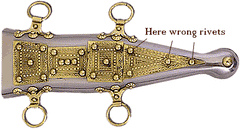Roman Pugio dagger sheath types
Correct nomenclature of Roman dagger sheath types & parts
Roman Pugio daggers were produced with matching sheaths of three types by the second quarter of the 1st century AD. All of these types had four assembled suspension rings. All evidences show, that the lower pair of rings was unused.

Pugio sheath type 'A'
Type 'A' was made with a curving iron plate at both front and back, surrounding a wooden 'lining'. The front plate was usually heavily decorated with brass, silver, niello and colored enamel. Type 'A' sheaths featured round free-running suspension rings, attached by branched riveted mountings. Reconstructions featuring decorative plates attached by rivets are incorrect and have never been found. This common mistake is justified by a misinterpretation of a archeological line drawing of a type 'A' sheath decorated with silver inlay and decorative rivets.

Pugio sheath type 'B'
The type 'B' was a wooden sheath, probably covered with leather to the front of which an iron plate had been attached. This front plate was nearly flat and heavily decorated with inlaid silver or tin and enamel. The suspension rings were similiar to Roman military buckles and hinged to the sides.

Pugio sheath 'frame type'
The 'frame type' was made of iron and consisted of a pair of curved channels which are connected at the lower end. The channels are joined by two horizontal bands at the top and middle of the sheath. These bands also retain the suspension rings, which are round like those of type 'A'. These sheaths would have been built around a wooden core.


